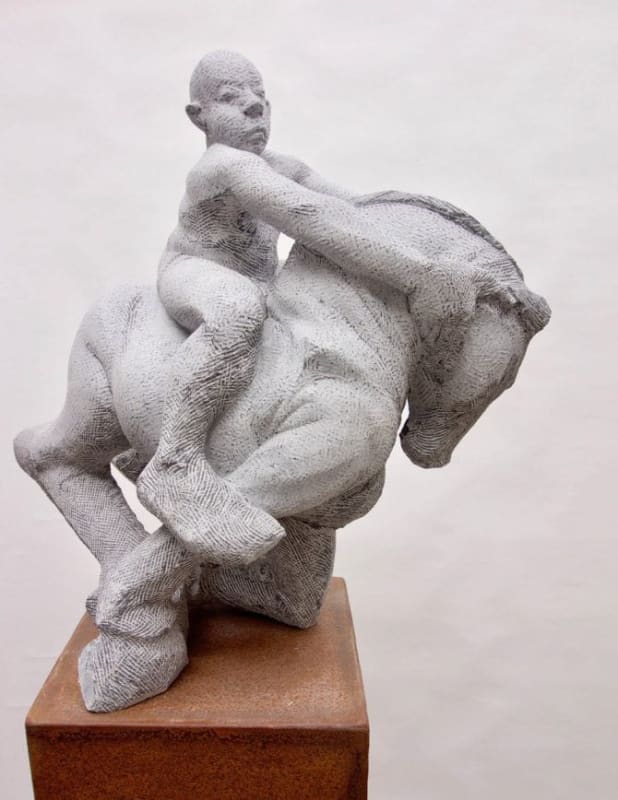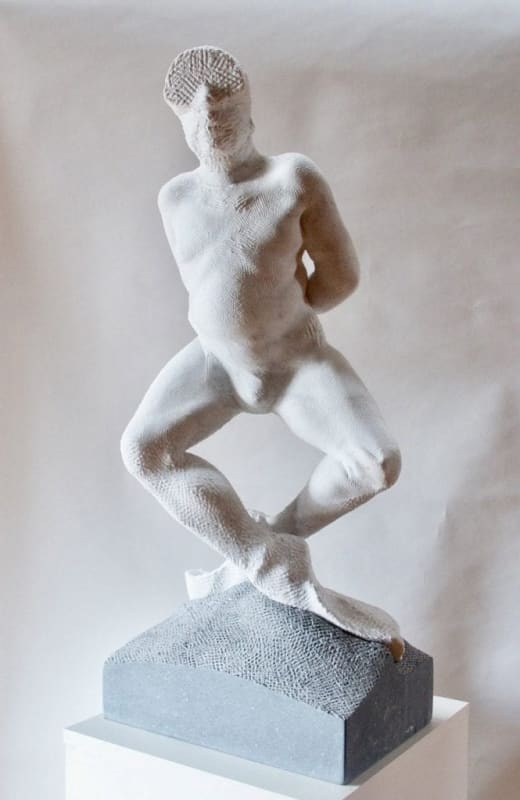What are the themes running through your new exhibition?
Within the exhibition, three main themes that have found expression through my sculpture over the last three decades are present: the horse and rider theme is like my exercise book, my sketch book where I study the relationship between animal and human. Here I’m concerning myself with the connectedness between the elements: yet within our individual natures also the isolation.
The figure with the live quadruped theme again is concerned with the connectedness. This thread started in the late 1980s with an eye to genetics and their modification and species development, destruction and extinction. Some of my very earliest sculptures were of dodo-like birds. The quadrupeds have always been female. Thirdly, the Buoyeds theme is concerned with levity and gravity and much else besides.
What was your starting point and how long have you been working on the pieces?
These 12 works in total took the best part of 18 months to produce. My starting point for many of the works was to orientate the original block in the most precarious balance point possible and force my abilities to render my subjects from that. The two pieces that were coaxed into being from this beginning were Horse and Rider II and Falling Horse and Rider. It was like a riddle waiting to be solved: rotating the blocks and confusing myself with different gravitational planes until eventually a single illusion of gravity was expressed. For figurative sculpture gravity is the illusion. Creating a visual of the effect of gravity on flesh produces the form convincingly: light, texture, mass and depth, unlike with a two-dimensional work.
How and where do you work?
I work outdoors mostly in order to get the pieces started while creating much more dust than is good for a body. The advantage of living close to the coast in West Cork on a hill means that the air is never still and thankfully obviates the need for wearing a mask. I later use a “shedifice” where I do the lighter, less dusty work indoors. I’ve moved studio three times so I’m probably getting closer to an ideal studio and with another move coming in the near future I hope to be able to improve yet again on my work environment.
The method of approach for my sculpture is known as “direct carving”. Part and parcel of this process is that I don’t use maquettes, (models of the sculpture in clay, or wax or plasticine or drawings, as aides or as a starting point). Everything is worked out in the process of carving during the removal of the unwanted material. The tungsten carbide tipped chisel scrapes the stone and leaves a visible trace. On the limestone it’s a white abrasion on the black/grey stone. This is the drawing until eventually hundreds of thousands of these, each subsequently obliterating its predecessor in the area concerned, tightening the surface of the flabby boulder, and drawing it ultimately into a deliberate form that has an accompanying subject and meaning. The subject and meaning are the genesis. The big bang of starting points.
Do you have any favourite pieces in the exhibition?
Yes, Carbon Sync is a piece that really fired my imagination. It is the most recent in the theme-thread of the Buoyeds and it develops further ideas around universal human concerns. Using the timber has energised this thread to a new quantum level and the material itself has added meaning.
Fundamental to my practice is an awareness of gravity. This was forced upon me in many ways. I suppose, firstly by my engagement with massive weights, 25 tonnes in one instance, and working without hydraulics and mechanisation, just the lever and the roller and the wedge. Secondly I realised that innate within me is a deep appreciation of what’s plumb. With that I found myself continually and subconsciously adjusting to gravity. I realised that the cosmos relies on gravity in every aspect to bring it to order.
Each individual “Buoyed” is nuanced by some other additional element. In the case of Carbon Sync the peculiarity is the material itself and so gives it its name. The sculpture is infused with meanings around climate change, sea levels and buoyancy, life preservation and survival, levity, gravity and a suggestion that collectively we fail to take serious matters that affect our very survival and survive we do for the most part on levitation and buoyancy.
Need to know: Michael Quane’s “Recent Sculptures” exhibition is on at Solomon Fine Art, Balfe Street, Dublin 2 until July 6; thegloss.ie/artistic-license-michael-quane-rha/





